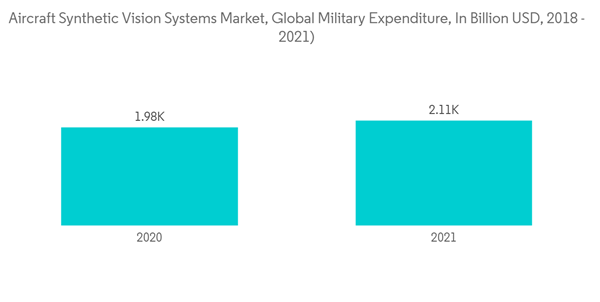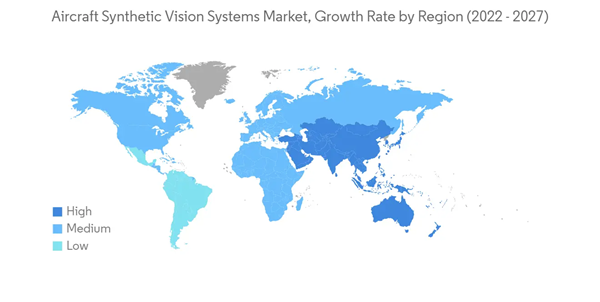The aircraft synthetic vision systems market is expected to register a CAGR of 2.8%.
The global aviation sector was disrupted due to the COVID-19 pandemic. However, the sector recovered in 2021 and 2022. Due to the COVID-19 pandemic, the commercial aviation sector has been significantly affected, resulting in a drastic reduction in passenger traffic, negatively affecting aircraft demand. The military aviation sector remained stable and even grew as most countries have not reduced their defense budget and remain committed to sustaining their military capabilities. Nevertheless, due to the widespread supply chain disruption, some military aircraft programs faced minor cost escalations and delays.
The increasing demand for new aircraft drives the synthetic vision systems market as part of the fleet expansion and modernization programs initiated by respective end-users in the military, commercial, and general aviation sectors. Such factors will drive the market in the coming years.
Multiple prominent nations are procuring combat aircraft to strengthen their combat capabilities. For instance, in May 2021, the US Air Force awarded a USD 14 billion contract to Lockheed Martin Corporation to produce 128 Block 70/72 jets on behalf of Bahrain, Slovakia, Bulgaria, Taiwan, and Morocco. Similarly, in January 2021, the Indian Ministry of Defense (MoD) cleared the purchase of 83 LCA MK1A Tejas light combat aircraft for USD 6.5 billion. Also, in July 2021, the UK MoD signed a USD 347 million agreement with Team Tempest to provide digital and physical infrastructure to develop the aircraft. Other nations are undertaking similar procurement initiatives across the world. Since these new-generation military aircraft feature state-of-the-art synthetic vision systems that enable the pilot to have 360-degree situational awareness, the demand for new-generation military aircraft is expected to create a parallel demand for synthetic vision systems.
Hence, aircraft OEMs have started beefing up their production capabilities to cope with the ever-increasing demand. In September 2021, Airbus was developing a newly enhanced flight vision system (EFVS) for its A320 family of aircraft, which is expected to be adapted to other models eventually, and selections of a next-generation enhanced vision sensor to be supplied to Airbus by Collins Aerospace. The EFVS currently under development consists of the sensor, a multi-special camera system, head-up display (HUD), and cockpit controls, and eventually could be adapted to other Airbus aircraft models in addition to the A320.
Indigenous aircraft development programs are anticipated to bolster regional fire protection system manufacturers and integrators' business prospects. For instance, as part of its Air Superiority 2030 program, the US Air Force (USAF) is developing two new high-tech fighter aircraft, dubbed the Penetrating Counter Air. The USAF expects to ramp up funding to USD 1.4 billion in FY20 and USD 3.1 billion in 2022 for developing advanced air combat systems. Such investment and technological development are expected to boost the Aircraft Synthetic Vision Systems Market in the coming year.
This product will be delivered within 2 business days.
The global aviation sector was disrupted due to the COVID-19 pandemic. However, the sector recovered in 2021 and 2022. Due to the COVID-19 pandemic, the commercial aviation sector has been significantly affected, resulting in a drastic reduction in passenger traffic, negatively affecting aircraft demand. The military aviation sector remained stable and even grew as most countries have not reduced their defense budget and remain committed to sustaining their military capabilities. Nevertheless, due to the widespread supply chain disruption, some military aircraft programs faced minor cost escalations and delays.
The increasing demand for new aircraft drives the synthetic vision systems market as part of the fleet expansion and modernization programs initiated by respective end-users in the military, commercial, and general aviation sectors. Such factors will drive the market in the coming years.
Aircraft Synthetic Vision Systems Market Trends
Military End-user to Witness Higher Growth During the Forecast Period
The emerging geopolitical rift among nations has fostered the need for the induction of advanced military assets, including aircraft. The subsequent increase in defense expenditure also aims to accelerate ongoing and new procurement programs for new-generation platforms. In 2021, the world military expenditure surpassed the two trillion US dollar mark for the first time, reaching USD 2,113 billion. Global spending in 2021 was 0.7% higher than in 2020 and 12% higher than in 2012.Multiple prominent nations are procuring combat aircraft to strengthen their combat capabilities. For instance, in May 2021, the US Air Force awarded a USD 14 billion contract to Lockheed Martin Corporation to produce 128 Block 70/72 jets on behalf of Bahrain, Slovakia, Bulgaria, Taiwan, and Morocco. Similarly, in January 2021, the Indian Ministry of Defense (MoD) cleared the purchase of 83 LCA MK1A Tejas light combat aircraft for USD 6.5 billion. Also, in July 2021, the UK MoD signed a USD 347 million agreement with Team Tempest to provide digital and physical infrastructure to develop the aircraft. Other nations are undertaking similar procurement initiatives across the world. Since these new-generation military aircraft feature state-of-the-art synthetic vision systems that enable the pilot to have 360-degree situational awareness, the demand for new-generation military aircraft is expected to create a parallel demand for synthetic vision systems.
North America to Dominate the Market During the Forecast Period
The aerospace industry in the region is mature and strongly supported by a robust aviation base. Higher air traffic has resulted in the procurement of several aircraft by regional and international airline operators in the region. Boeing, one of the major aircraft OEMs based in the US, generates a huge demand for aircraft fire protection systems. As the OEMs receive new orders for aircraft, the demand is simultaneously generated for commercial aircraft fire protection systems, as FAA mandates the installation of evacuation systems in all active aircraft. Factors such as the availability of raw materials, political stability, and low production costs have driven the establishment of new aerospace manufacturing facilities in the region. Also, fluctuations in aviation fuel prices have triggered a surge in demand for fuel-efficient new-generation aircraft worldwide.Hence, aircraft OEMs have started beefing up their production capabilities to cope with the ever-increasing demand. In September 2021, Airbus was developing a newly enhanced flight vision system (EFVS) for its A320 family of aircraft, which is expected to be adapted to other models eventually, and selections of a next-generation enhanced vision sensor to be supplied to Airbus by Collins Aerospace. The EFVS currently under development consists of the sensor, a multi-special camera system, head-up display (HUD), and cockpit controls, and eventually could be adapted to other Airbus aircraft models in addition to the A320.
Indigenous aircraft development programs are anticipated to bolster regional fire protection system manufacturers and integrators' business prospects. For instance, as part of its Air Superiority 2030 program, the US Air Force (USAF) is developing two new high-tech fighter aircraft, dubbed the Penetrating Counter Air. The USAF expects to ramp up funding to USD 1.4 billion in FY20 and USD 3.1 billion in 2022 for developing advanced air combat systems. Such investment and technological development are expected to boost the Aircraft Synthetic Vision Systems Market in the coming year.
Aircraft Synthetic Vision Systems Market Competitor Analysis
Major players in the aircraft synthetic vision systems market are Cobham Limited, Garmin Ltd, Honeywell International Inc., Thales Group, and Collins Aerospace (Raytheon Technologies Corporation). As synthetic vision systems (SVSs) become more mainstream, players are refining their products to appeal to a broader range of customers. Along with general aviation operators, key targets of the players include the rotorcraft and commercial aviation markets. However, for commercial and general aviation users, in addition to providing situational awareness, the market players are also expected to design synthetic vision systems keeping in mind the potential for economic returns. The systems are required to be less prone to malfunction or breakdown, eliminating or reducing the need for frequent upgrades and maintenance, which may attract new customers for players, helping them gain higher market shares.Additional benefits of purchasing the report:
- The market estimate (ME) sheet in Excel format
- 3 months of analyst support
This product will be delivered within 2 business days.
Table of Contents
1 INTRODUCTION
4 MARKET DYNAMICS
5 MARKET SEGMENTATION (Market Size by Value - USD million)
6 COMPETITIVE LANDSCAPE
Companies Mentioned (Partial List)
A selection of companies mentioned in this report includes, but is not limited to:
- Cobham Limited
- Garmin Ltd
- Honeywell International Inc.
- Thales Group
- Collins Aerospace (Raytheon Technologies Corporation)
- Safran SA
- Aspen Avionics Inc.
- Avidyne Corporation
- Elbit Systems Ltd
- Mercury Systems Inc.
- L3Harris Technologies Inc.
- ENSCO Inc.
Methodology

LOADING...










